Year 10 Science Exam - Semester 2
1/189
Earn XP
Description and Tags
Earth Science, Physics, Space Science
Name | Mastery | Learn | Test | Matching | Spaced |
|---|
No study sessions yet.
190 Terms
What is weather?
The short-term atmospheric conditions in a specific place at a specific time, including temperature, humidity, precipitation, wind, and visibility. It can change from minute-to-minute, hour-to-hour, or day-to-day.
What is climate?
The long-term average of weather patterns in a particular region over a period of at least 30 years, including trends in temperature, precipitation, and seasonal variations.
Climate vs Weather
Weather is short-term and temporary
Climate describes long-term patterns and averages
What is the nitrogen cycle?
Movement of nitrogen through atmosphere, soil, plants, animals, and microorganisms
Makes nitrogen usable by living organisms, like plants, which then pass it through the food chain
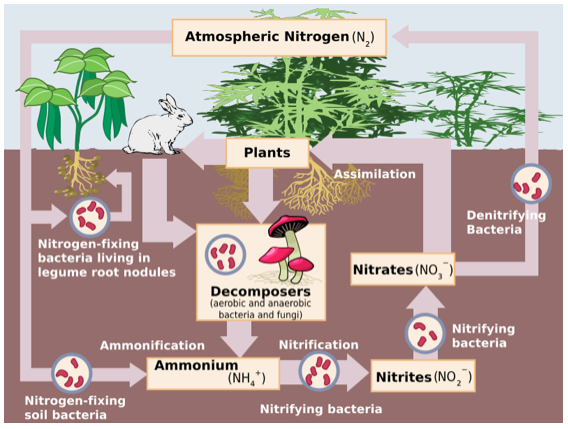
What is nitrogen fixation and which organisms perform it?
Converts atmospheric nitrogen (N₂) into ammonia (NH₃) or related compounds
Performed by nitrogen-fixing bacteria
Root nodules: Rhizobium
Free-living: Azotobacter
What is nitrification and which organisms are involved?
Converts ammonia (NH₃) → nitrites (NO₂⁻) → nitrates (NO₃⁻)
Nitrifying bacteria involved:
Nitrosomonas: ammonia → nitrite
Nitrobacter: nitrite → nitrate
What is denitrification and which organisms perform it?
Converts nitrates (NO₃⁻) back into nitrogen gas (N₂)
Done by denitrifying bacteria, e.g., Pseudomonas and Clostridium
Usually occurs in oxygen-poor soils
How do these processes connect in the nitrogen cycle?
Nitrogen fixation adds usable nitrogen to soil
Nitrification produces plant-absorbable forms
Plants and animals use nitrogen for growth
Denitrification returns nitrogen to the atmosphere
Maintains nitrogen balance in ecosystems
What’s assimilation?
Process where plants absorb nitrates and ammomium from the soil through their roots
Incorporate them into their cells to make proteins and nucleic acids
What is ammonification?
The process where decomposer bacteria and fungi break down organic nitrogen from dead plants and animals or animal waste
Converts organic nitrogen into ammonia (NH₃) or ammonium ions (NH₄⁺)
Recycles nitrogen back into the soil, making it available for nitrification
What is the role of leguminous plants in the nitrogen cycle?
Leguminous plants (e.g., beans, peas, clover) have root nodules containing Rhizobium bacteria
These bacteria fix atmospheric nitrogen (N₂) into ammonia (NH₃), which the plant can use
Increase nitrogen content in soil, enriching it for other plants
Help reduce the need for artificial nitrogen fertilisers in agriculture
How does lightning enrich soil with nitrates?
Lightning provides enough energy to break nitrogen gas (N₂) molecules in the atmosphere
Nitrogen atoms combine with oxygen to form nitrogen oxides (NO and NO₂)
These oxides dissolve in rain to form nitrates (NO₃⁻)
Nitrates are deposited into the soil, providing a natural source of nitrogen for plants
What causes the natural greenhouse effect?
Naturally occurring greenhouse gases (e.g., carbon dioxide, methane, water vapour) trap heat in the atmosphere
Solar radiation enters, warms Earth, and some heat is radiated back
Greenhouse gases absorb and re-radiate heat, keeping Earth’s temperature suitable for life
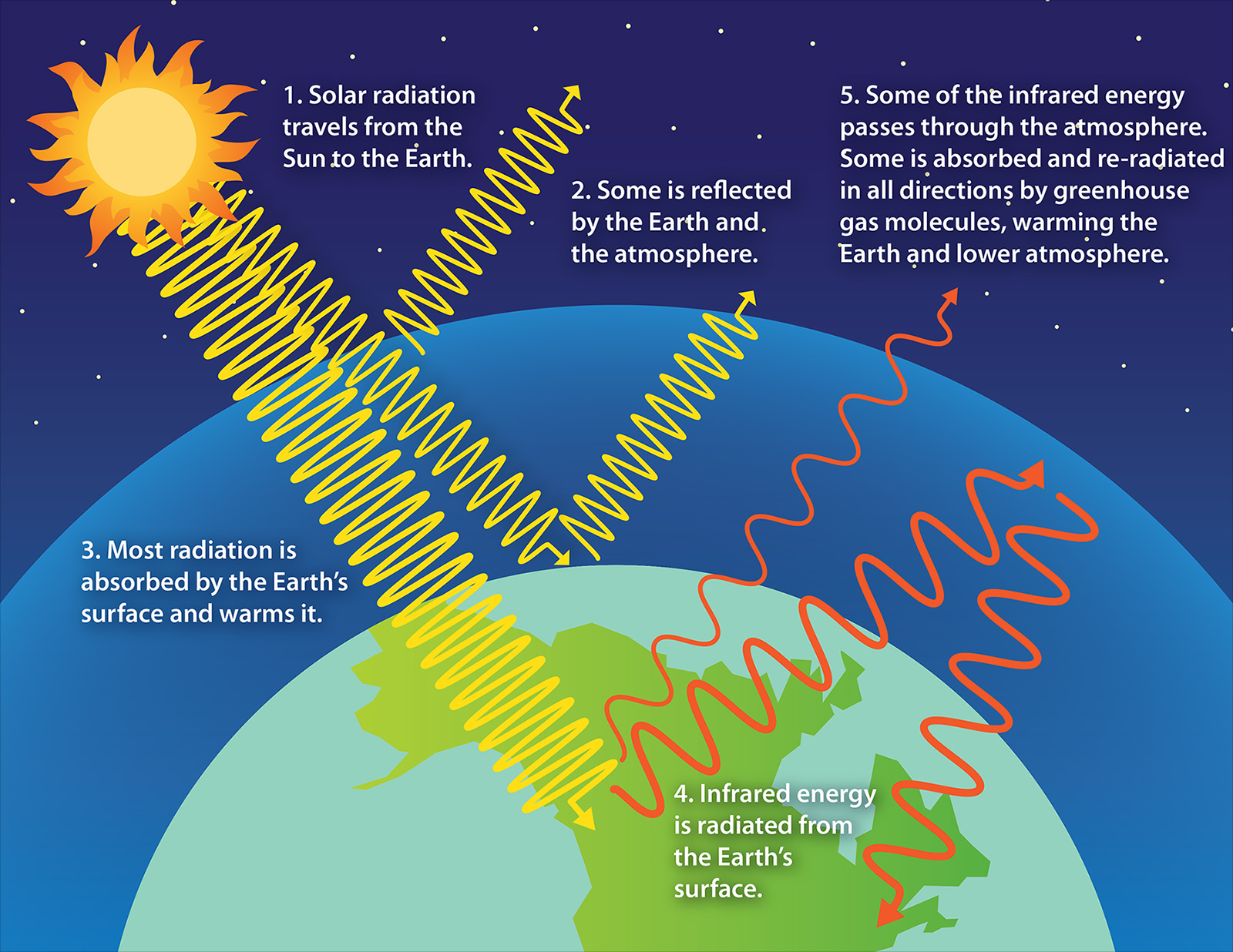
What are the effects of the natural greenhouse effect?
Maintains Earth’s average temperature around 15°C
Supports life by preventing extreme temperature fluctuations
What causes the enhanced greenhouse effect?
Human activities increase greenhouse gas concentrations (burning fossil fuels, deforestation, agriculture)
More heat is trapped than normal, disrupting Earth’s natural energy balance
What are the effects of the enhanced greenhouse effect?
Global warming and rising average temperatures
Melting polar ice and glaciers, sea-level rise
More extreme weather events (storms, droughts, heatwaves)
Disruption of ecosystems and biodiversity
Greenhouse Effect vs Enhanced Greenhouse Effect
Natural greenhouse effect: essential for life, balanced
Enhanced greenhouse effect: human-driven, causes climate change and environmental harm
What causes El Niño?
Weakening or reversal of the trade winds in the Pacific Ocean
Warm water from the western Pacific moves east toward South America
Reduces upwelling of cold, nutrient-rich water near South America
Alters global weather patterns
What are the impacts of El Niño on Australia?
Drier conditions, especially in eastern and northern Australia
Increased risk of drought and bushfires
Lower agricultural yields due to reduced rainfall
Warmer than average temperatures
What causes La Niña?
Strengthening of the trade winds in the Pacific Ocean
Warm water pushed further west toward Australia and Asia
Enhanced upwelling of cold water near South America
Opposite weather pattern to El Niño
What are the impacts of La Niña on Australia?
Wetter conditions, particularly in eastern and northern Australia
Increased risk of floods and cyclones
Higher agricultural yields in some regions due to more rainfall
Cooler than average temperatures in some areas
How does global warming affect sea ice and ocean temperatures?
Rising global temperatures cause polar ice to melt, reducing sea ice coverage
Warmer air and ocean water increase ocean temperatures, affecting marine ecosystems
Example of sea ice loss
Arctic sea ice has declined significantly over the past decades
Polar bears lose habitat for hunting and breeding, threatening populations
Example of increased ocean temperatures
Great Barrier Reef in Australia suffers from coral bleaching
Warmer waters stress corals, causing them to expel algae and turn white
Reduces biodiversity and affects fisheries and tourism
How are marine organisms impacted by global warming?
Rising sea temperatures:
Causes coral bleaching (e.g., Great Barrier Reef)
Disrupts breeding and migration patterns of fish and marine mammals
Ocean acidification:
Increased CO₂ dissolves in seawater, lowering pH
Weakens shells and skeletons of molluscs, corals, and some plankton
Loss of sea ice:
Polar species like penguins and polar bears lose habitat
Reduces hunting grounds and breeding areas
Changes in ocean currents:
Alters nutrient distribution, affecting plankton growth and entire food webs
Extreme weather events:
Storms and cyclones damage reefs and coastal habitats
Overall impact:
Decline in biodiversity, reduced fish stocks, and disruption of marine ecosystems
What is the importance of ocean currents in regulating global climate?
Transport heat around the planet, moving warm water from the equator toward the poles and cold water from the poles toward the equator
Help regulate regional climates (e.g., Gulf Stream keeps Western Europe warmer)
Influence rainfall and weather patterns, affecting droughts and monsoons
How do ocean currents affect marine life?
Distribute nutrients through upwelling, supporting plankton growth and the marine food chain
Influence migration routes and breeding grounds of fish, whales, and turtles
Maintain oxygen levels and temperature ranges necessary for marine species survival
Changes in currents due to climate change can disrupt ecosystems, reduce fish stocks, and affect biodiversity
What is the carbon cycle?
The carbon cycle is the movement of carbon through the atmosphere, biosphere, hydrosphere, and geosphere
Ensures carbon is available for life, stored in plants, animals, soils, oceans, and rocks

What is photosynthesis in the carbon cycle?
Plants, algae, and some bacteria absorb carbon dioxide (CO₂) from the atmosphere
Convert CO₂ and sunlight into glucose (C₆H₁₂O₆) and oxygen (O₂)
Removes carbon from the atmosphere and stores it in living organisms
What is respiration in the carbon cycle?
Plants, animals, and microbes release carbon dioxide back into the atmosphere by breaking down glucose for energy
Occurs in all living organisms continuously
What is decomposition in the carbon cycle?
Decomposers (bacteria and fungi) break down dead organisms and waste
Release carbon back into the soil and atmosphere as CO₂ or methane (CH₄)
What is consumption in the carbon cycle?
Animals eat plants or other animals, transferring carbon through the food chain
Carbon becomes part of their bodies until released via respiration, waste, or death
What is combustion in the carbon cycle?
Burning of fossil fuels, wood, or other organic matter
Releases stored carbon back into the atmosphere as CO₂
What is mining in the carbon cycle?
Extraction of fossil fuels like coal, oil, and natural gas
Makes carbon stored underground available for combustion
What is sedimentation (fossil fuel formation) in the carbon cycle?
Dead plants and animals are buried and compressed over millions of years
Forms coal, oil, and natural gas, storing carbon in the Earth’s crust for long periods
How do the processors for the cabron cycle connect?
Photosynthesis removes CO₂ from the atmosphere
Respiration, decomposition, and combustion return CO₂ to the atmosphere
Consumption transfers carbon through ecosystems
Sedimentation and fossil fuel formation store carbon long-term
Mining and burning fossil fuels release stored carbon, influencing global climate
What is a model that shows the natural cycling of matter in the biosphere?
The ecosystem or biogeochemical cycle model illustrates how matter moves through living and non-living components of the biosphere
Components of the model:
Producers (plants, algae): take in nutrients and carbon via photosynthesis
Consumers (animals): obtain matter by eating producers or other consumers
Decomposers (bacteria, fungi): break down dead organisms and waste, returning nutrients to the soil
Abiotic components (air, water, soil): provide nutrients and carbon for living organisms
Flows in the model:
Nutrients and elements like carbon, nitrogen, and phosphorus cycle between organisms and the environment
Energy flows one-way through the food chain, while matter cycles continuously
Purpose: shows how matter is recycled, maintaining ecosystem balance and sustaining life
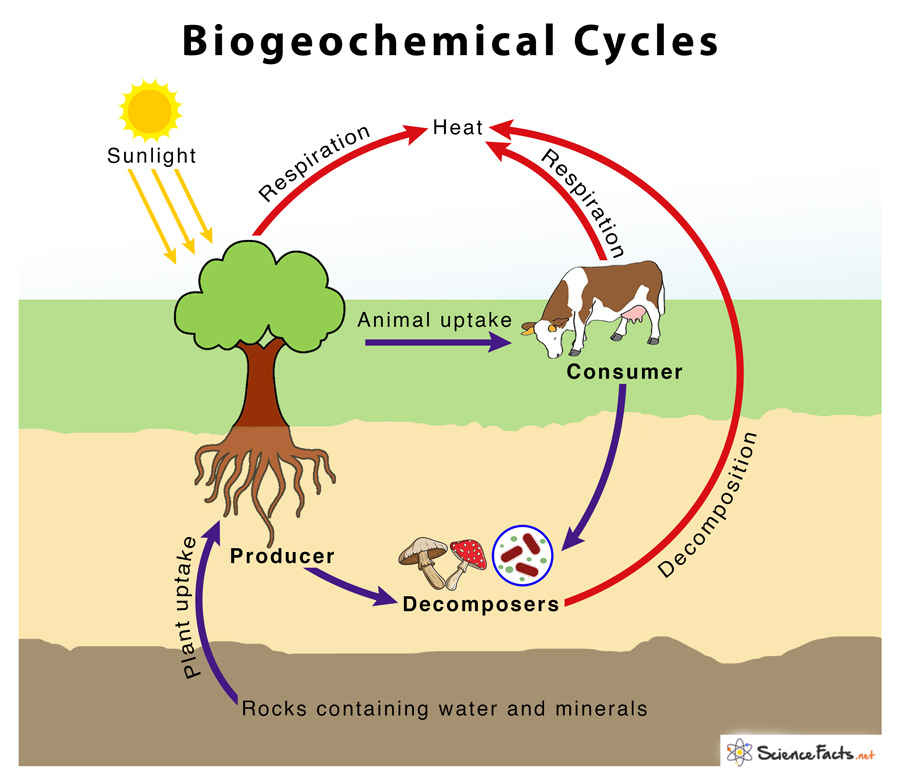
What is a light year?
The distance light travels in one Earth year.
Approx. 9.46 trillion km
Trillion in scientific notation
1012
How to convert between light years (ly) and kilometres?
Light years → kilometers: ly × 9.46 × 1012
Kilometers → light years: km ÷ 9.46 × 1012
What’s a parsec?
A unit used to measure astronomical distances based on geometry rather than the speed of light.
1 parsec ≈ 3.26 light years
1 parsec ≈ 3.086 × 10¹³ km
Converting between light years and parsecs
Parsecs: ly ÷ 3.26
Ly: pc × 3.26
How to convert between parsecs and kilometres?
Parsecs → kilometers: pc × 3.08 × 1013
Kilometres → parsecs: km ÷ 3.08 × 1013
What is parallax?
The apparent shift in a star’s position when viewed from different locations.
By measuring the angles to the stars and using trigonometry, the distance to the star can be calculated.
Why does parallax occur?
Because Earth changes position as it orbits the Sun, causing nearby stars to appear to move slightly relative to distant stars.
What two positions are used to measure parallax?
Observations taken six months apart - when Earth is on opposite sides of its orbit.
What does a smaller parallax angle mean
The further away the star is
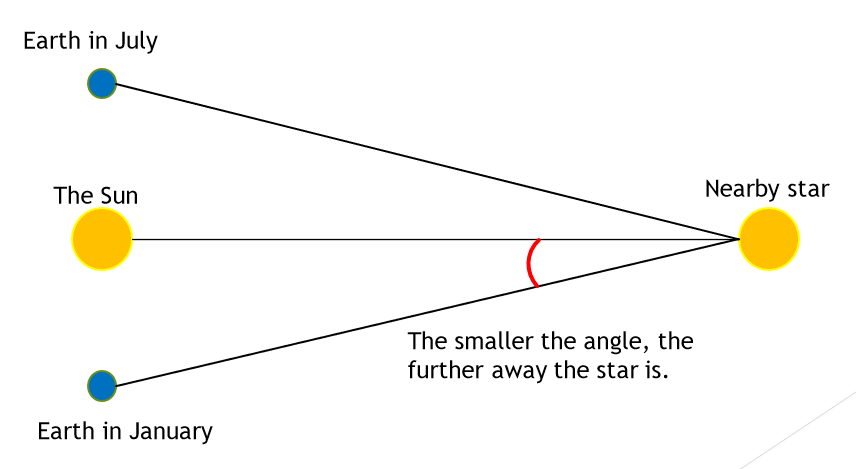
How is the distance to a star calculated using parallax?
Distance (in parsecs) = 1 ÷ parallax angle
Why can parallax only be used for nearby stars?
Because for distant stars, the parallax angle becomes too small to measure accurately.
What is a nebula?
A large cloud of gas and dust in space, where stars begin to form.
How do stars form from a nebula?
Gravity pulls the gas particles together, causing heat and pressure to rise at the center. Eventually, it may become hot enough to “ignite” forming a protostar.
What are the 2 most common gases found in nebulae?
Hydrogen
Helium
They are the smallest and most abundant elements in the universe.
What is nuclear fusion?
The process where atomic nuclei combine to form heavier elements, releasing huge amounts of energy and powering stars.
What causes nuclear fusion?
The immense temperature and pressure in a star’s core force hydrogen nuclei close enough to overcome their natural repulsion, allowing them to fuse and release energy.
What is a protostar?
A forming star created when gravity pulls gas and dust from a nebula together, heating up as it collapses.
What is a main sequence star (MSS)?
A stable star where hydrogen is fused into helium at the core, releasing energy and balancing gravity.
What is a red giant (or red supergiant)?
A large, cool star that forms after hydrogen runs out and helium fusion begins, causing the star to expand.
Red supergiant only: This nuclear fusion releases enormous amounts of energy, causing the star to expand again, reaching 100 million to 1 billion km in diameter.
What is a planetary nebula?
The outer layers of a dying average star that drift into space, leaving the hot core behind. These clouds of gas may eventually reform new stars.
What is a white dwarf?
The small, hot, dense core left after a planetary nebula; it slowly cools and fades.
What is a black dwarf?
A theoretical final stage of a white dwarf’s life where it is very hot but no longer produces energy through fusion. Over trillions of years, it will cool down and stop glowing completely.
What is a supernova?
A massive explosion that occurs when a large star runs out of fuel and its core collapses.
What is a neutron star?
The extremely dense core left after a supernova, made mostly of neutrons.
What is a black hole?
A point in space with gravity so strong that not even light can escape, formed from the collapse of a very massive star.
Life cycle of an average-sized star
Nebula
Protostar
Main Sequence Star
Red Giant
Planetary Nebula
White Dwarf
Life cycle of a massive star
Nebula
Protostar
Main Sequence Star
Red Supergiant
Supernova
Neutron Star (if not too massive) or Black Hole (if extremely massive)
What is the brightness of a star?
How much light or energy it gives off.
What is apparent brightness?
How bright a star appears from Earth.
It depends on both the star’s actual light output and its distance from us.
A nearby dim star can look brighter than a faraway luminous one.
What is absolute brightness?
The star’s true brightness — how bright it would appear if it were 10 parsecs (32.6 light years) away.
This lets astronomers compare stars fairly, without distance affecting the result.
If the value is less than 1, it is brighter than our sun
Greater than 1 indicates a star is less bright than the sun
Brightness of each type of star?
Red dwarfs: faint
Main Sequence Star: moderate
Red giants: bright
Red supergiants: extremely bright
White dwarfs: faint
Supernovae: brightest of all (but short lived)
What is a Cepheid variable?
A type of star that regularly gets brighter and dimmer due to changes in its size and temperature.
What causes a Cepheid variable’s brightness to change?
The star expands and contracts in a repeating cycle, which alters its temperature and light output.
What is the period–luminosity relationship?
The longer the period (time between brightness peaks), the brighter the Cepheid’s true luminosity.
How do astronomers use Cepheid variables to find a star’s absolute brightness?
They measure the star’s period of brightness variation, then use the period–luminosity relationship to calculate its true brightness (absolute magnitude).
How can Cepheid variables be used to find distance?
By comparing the star’s absolute brightness (true luminosity) with its apparent brightness (how bright it looks from Earth).
Why are Cepheid variables important in astronomy?
They act as “standard candles” — reliable distance markers for measuring how far away galaxies and stars are.
What determines a star’s colour?
Its surface temperature.
What colour are the hottest stars?
Blue — with surface temperatures above 25,000 °C.
What colour are medium-temperature stars like the Sun?
Yellow — around 6,000 °C.
What colour are the coolest stars?
Red — about 2,000–3,500 °C.
What is the general relationship between star colour and temperature?
Hotter stars appear bluer, while cooler stars appear redder.
What is a Hertzsprung-Russell diagram?
A diagram that shows the relationship between the brightness and temperature of a star.
With this info, we can identify what stage of its life cycle a star is in.
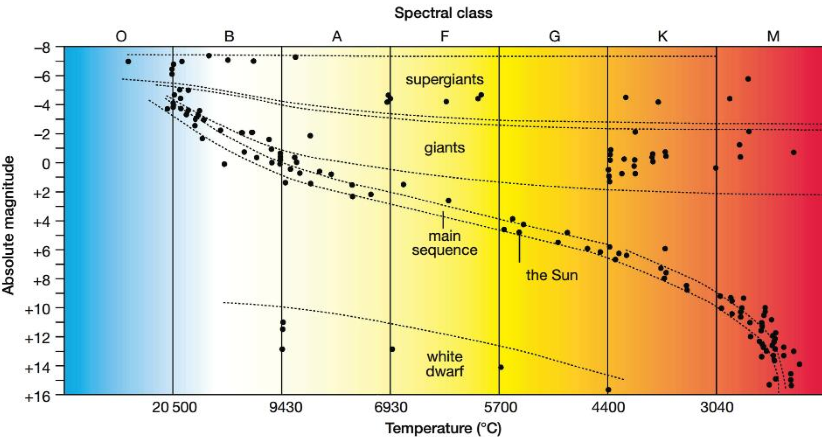
Why are 90% of stars found in the MSS?
It’s the longest and most stable phase in a star’s life.
How do galaxies form?
Small density differences after the Big Bang caused matter to clump together. Over time, these clumps formed stars, which grouped into galaxies containing stars and planets.
What is the Doppler effect in light?
The change in the observed wavelength (and colour) of light caused by the motion of the source relative to the observer.
What happens to light from an object moving towards us?
The wavelengths are compressed, making the light appear bluer — this is called a blue shift.
What happens to light from an object moving away from us?
The wavelengths are stretched, making the light appear redder — this is called a red shift.
What does a red shift tell astronomers?
That the object (like a galaxy) is moving away from Earth.
What does a blue shift tell astronomers?
That the object is moving towards Earth.
Why is the Doppler effect important in astronomy?
It helps scientists measure how fast stars and galaxies are moving, and supports evidence that the universe is expanding.
What is Cosmic Microwave Background Radiation (CMB)?
The faint microwave afterglow of the Big Bang, left over as the universe expanded and cooled.
How does CMB support the BBT?
It shows that the universe began as hot and dense, then expanded.
What makes up a universe?
Billions of galaxies that are all many light years away from each other
What does the BBT describe?
The universe began with an enormous explosion of energy and then it expanded from an extremely small, extremely hot and extremely dense state.
Evidence of the BBT
CMB
Redshift/blueshift
Abundance of light elements (Hydrogen, Helium)
What does the Solid State Theory describe?
The universe is infinite in extent and that it has always existed in a similar form to what is observed today

BBT vs SST
BBT:
Starting point
Expansion from a singularity from a hot, dense state to its current structure
SST:
External universe with no begging or end/eternal universe with no beginning or end
Stages of evolution in the universe
Singularity forms
Time and space form; space expands rapidly
Light matter forms – electrons, positrons
Heavier matter forms – protons, neutrons
Universe cools; reaches size of solar system
Universe cools to 10¹⁰ °C
Atomic nuclei form
Universe cools to 3000 °C
First stars appear
Galaxies begin to form
What are positrons?
The antimatter version of an electron
It has the same mass as an electron.
It has the same amount of charge, but it’s positive instead of negative.
How does the relative abundance of hydrogen and helium support the Big Bang Theory?
After the Big Bang, the universe was extremely hot and dense.
Fusion turned some hydrogen into helium before the universe cooled.
This left about 75% hydrogen and 25% helium.
These amounts match what we observe today.
Shows there were fusion at the beginning of our universe
What are the five main reasons we explore space today?
Scientific discovery, national security, commercial profit, benefits for life on Earth, and ensuring our future.